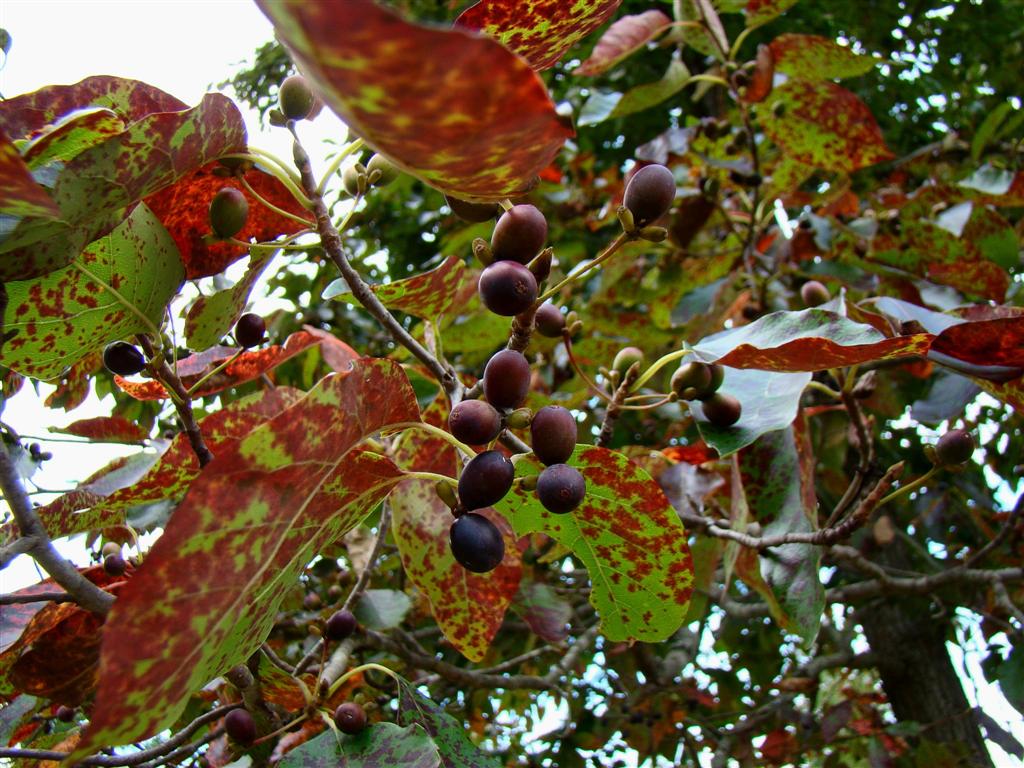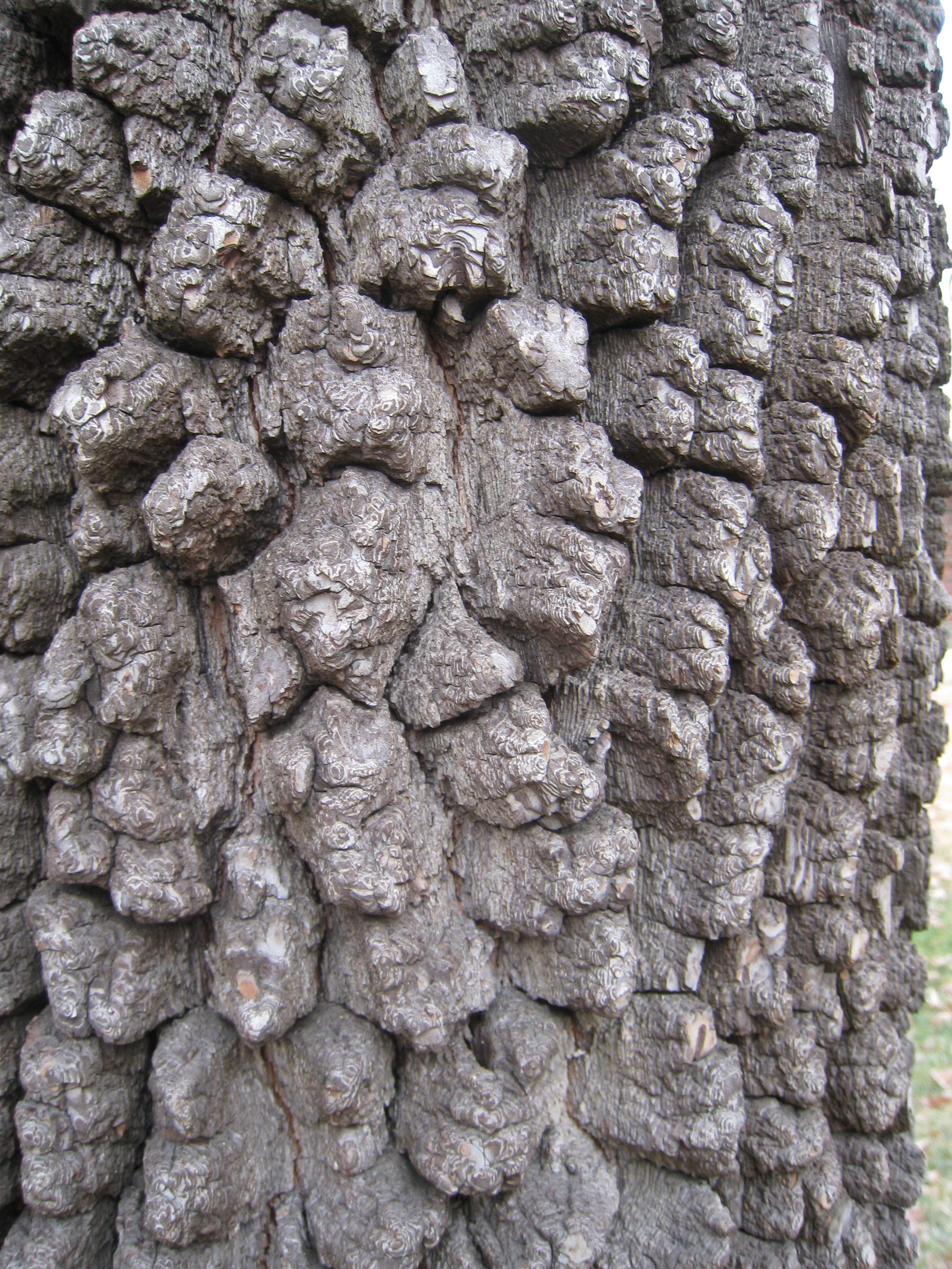We know our volunteer work is fun and rewarding, but we also realize that being ready to plant trees at 9:00AM on a Saturday morning can be tough – especially if it’s cold or rainy (or in the case of this weekend, snowing!). Luckily for our volunteers, for the fourth year in a row Starbucks is a contributing sponsor for the 2011 fall Community Tree Planting season! At most tree planting events, you’ll find Starbucks coffee at the Casey Trees registration table. Volunteers can help themselves to a hot cup of joe to wake up, stay warm and get moving.
Starbucks’ generosity provides a reminder of what goes into each Casey Trees planting event. Our grassroots approach to beautifying this city means that both our applicants, and Casey Trees, rely heavily on our volunteers for much of our labor needs in planting trees. In turn, Casey Trees provides groups with the tools, training, technical assistance, and of course the trees, at no cost to them. In order to continue the success of our Community Tree Planting program, support like this from our neighborhood partners and friends is invaluable.
To learn how you can help out, visit our donation page to make a financial or in-kind contribution for an upcoming tree planting. Or, as always, you can get involved by volunteering and lending a hand at one of our many events. The bottom line is, whether you’re one of the world’s biggest coffee shops, or just one individual, there is no shortage of ways in which you can help support us in restoring the tree canopy of our Nation’s Capital.
Monday, October 31, 2011
Thursday, October 27, 2011
Live Green and Casey Trees Partner Up to Save You Money
Looking to save money while helping out in your community this fall? Well you’re in luck! For a limited time Casey Trees is partnering up with Live Green to make eco-friendly living a little more easy, fun, and affordable in the DC Metro Area.
 From now until the end of the year, for every new Live Green membership sold, a donation of $10 will be made to Casey Trees and our tree planting initiatives. By going to www.livegreen.net/join and typing in the referral code: CaseyTreesLG you will join the thousands who already enjoy the discounts and deals offered daily around the city, while helping us add some trees to the District!
From now until the end of the year, for every new Live Green membership sold, a donation of $10 will be made to Casey Trees and our tree planting initiatives. By going to www.livegreen.net/join and typing in the referral code: CaseyTreesLG you will join the thousands who already enjoy the discounts and deals offered daily around the city, while helping us add some trees to the District!
Live Green is a DC-based organization that partners with eco-friendly businesses and provides them with exposure to their network of environmentally-conscious members who get exclusive discounts on green products, services, or events. A Live Green membership includes a Live Green discount card that you can use at over 50 participating businesses throughout the DC Metro Area. Since each company they endorse is carefully screened based on their affordability, quality, and sustainable business practices, you can be sure you’re shopping responsibly and supporting socially conscious businesses – all while saving some money.
This fall season make the jump to go "green" while saving some “green” and see what a Live Green membership can do for you.
 From now until the end of the year, for every new Live Green membership sold, a donation of $10 will be made to Casey Trees and our tree planting initiatives. By going to www.livegreen.net/join and typing in the referral code: CaseyTreesLG you will join the thousands who already enjoy the discounts and deals offered daily around the city, while helping us add some trees to the District!
From now until the end of the year, for every new Live Green membership sold, a donation of $10 will be made to Casey Trees and our tree planting initiatives. By going to www.livegreen.net/join and typing in the referral code: CaseyTreesLG you will join the thousands who already enjoy the discounts and deals offered daily around the city, while helping us add some trees to the District!Live Green is a DC-based organization that partners with eco-friendly businesses and provides them with exposure to their network of environmentally-conscious members who get exclusive discounts on green products, services, or events. A Live Green membership includes a Live Green discount card that you can use at over 50 participating businesses throughout the DC Metro Area. Since each company they endorse is carefully screened based on their affordability, quality, and sustainable business practices, you can be sure you’re shopping responsibly and supporting socially conscious businesses – all while saving some money.
This fall season make the jump to go "green" while saving some “green” and see what a Live Green membership can do for you.
Wednesday, October 26, 2011
Washington Nationals Dream Foundation Brings Trees to Chamberlain Elementary
On Thursday October 13th students at Chamberlain Elementary in Southeast DC got a special surprise from Casey Trees: four new trees to be planted on their school grounds.
Despite a few clouds and a bit of rainy weather, 11 students from second and third grade classrooms came out to plant one river birch, one American basswood, one American hornbeam and one sweetgum alongside faculty and a handful of Casey Trees staff members. Even a few eager pre-k students, who are learning about trees in class, came out with their teachers to watch the planting unfold and share their knowledge with us all.
This planting event was especially meaningful to Casey Trees, however, because of one very special partner: The Washington Nationals Dream Foundation. Thanks in part to a generous donation from the Dream Foundation, Casey Trees was able to provide Chamberlain students with a new, outdoor natural classroom – one that they created with their own hands.
The Washington Nationals Dream Foundation, the charitable arm of the Washington Nationals Baseball Club, is dedicated to forging community partnerships that improve the lives of area children and their families. Established in 2007, the Foundation’s cornerstone programs focus on children’s education, health and recreation.
From all of us at Casey Trees, we’d like to send a big thank you to the Washington Nationals Dream Foundation for their help in bringing trees to Chamberlain Elementary School this fall. Whether these students will be enjoying a long recess or an impromptu outdoor science class, this donation will help to greatly increase the quality of the time they spend at school.
To learn how you can help our school community tree planting initiatives, visit our website or contact Mark DeSantis, Development Associate, at 202.833.9125.
Despite a few clouds and a bit of rainy weather, 11 students from second and third grade classrooms came out to plant one river birch, one American basswood, one American hornbeam and one sweetgum alongside faculty and a handful of Casey Trees staff members. Even a few eager pre-k students, who are learning about trees in class, came out with their teachers to watch the planting unfold and share their knowledge with us all.
This planting event was especially meaningful to Casey Trees, however, because of one very special partner: The Washington Nationals Dream Foundation. Thanks in part to a generous donation from the Dream Foundation, Casey Trees was able to provide Chamberlain students with a new, outdoor natural classroom – one that they created with their own hands.
 |
| Casey Trees staff member, Jabbari Brew, gives Chamberlain students safety tips before their October 13th planting. |
To learn how you can help our school community tree planting initiatives, visit our website or contact Mark DeSantis, Development Associate, at 202.833.9125.
Friday, October 21, 2011
Fall Foliage to Look Out for in D.C.
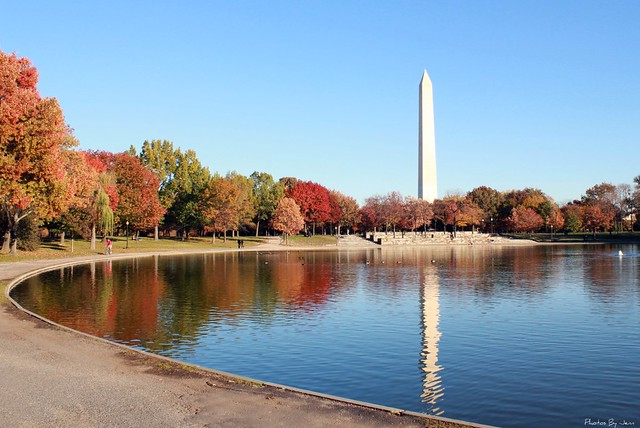 |
| Photo credit: Jennuine Captures. |
With all the brilliant colors popping up around D.C., we can't possibly cover every changing tree in our Tree of the month posts. So we've compiled a short list of beautiful trees to look out for during the remainder of the fall season. Hit the town and enjoy them!
- American beech trees (Fagus grandifolia) - Find the beech's simple yellow leaves at the U.S. Capitol grounds, Dumbarton Oaks and along the Capital Crescent trail. Also look out for the European beech trees (Fagus sylvatica) , whose leaves change to yellow or orange later on in the season.
- Red maples (Acer rubrum) - All trees in the maple family sport fall foliage, but the red maple is particularly note-worthy. Its leaves usually turn crimson, but it can also display yellow, purple and orange. Find the red maple in front of the Smithsonian National Museum of the American Indian and on the White House grounds (Jimmy Carter planted a red maple there in 1977!).
- Sweetgum (Liquidambar styraciflua) - The star-shaped sweetgum leaves can turn a multitude of colors. Oftentimes, several colors will appear on one tree. Check it out near the Vietnam Veterans Memorial, at the National Zoo and in West Potomac Park.
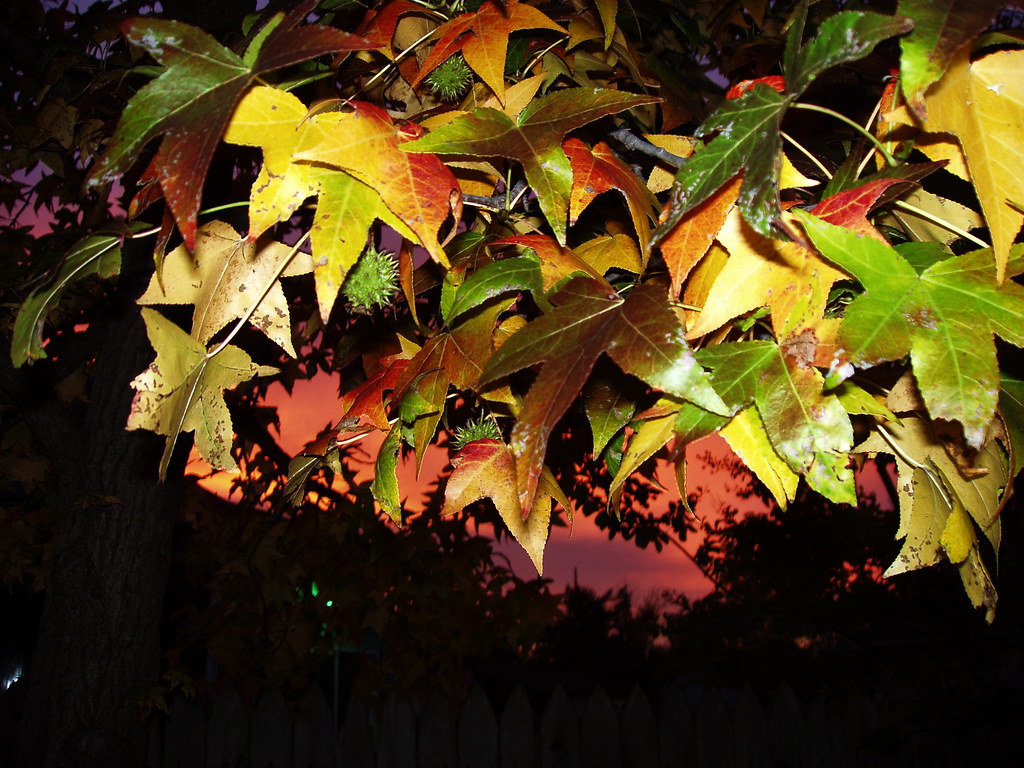 |
| Multi-colored sweetgum leaves. Photo credit: liberalmind1012. |
- White oak (Quercus alba) - The white oak can be found all over D.C., including at Dumbarton Oaks, Tudor Place, Logan Circle, Cedar Hill and the Capital Crescent Trail. Most white oak leaves turn red, but some turn a gorgeously rare deep-wine.
- Sourwood (Oxydendrum arboreum) - Similar to the white oak, sourwood leaves can sometimes turn a deep shade of red. Other times, they display a brighter orange-red color. Find these simple oval-leafed trees at Glenwood Cemetery and the U.S. Botanic Garden on Maryland Ave SW.
 |
| Find white oaks like this all over D.C. Photo credit: Tie Guy II. |
For more help identifying tree species, visit our resources page!
Monday, October 17, 2011
Charitable Foundation of the Energy Bar Association Sponsors Community Tree Planing, Southwest Rejoices
 |
| CFEBA volunteers celebrate the addition of 17 streets in Capitol Quarter. |
Our fall
Community Tree Planting (CTP) season continued this past weekend with two tree
planting events that added 29 new trees to the District. One planting in particular was especially
meaningful – the Capitol Quarter CTP – as Casey Trees partnered with the
event’s lead sponsor, the Charitable Foundation of the Energy Bar Association (CFEBA) to plant 17 trees in
one of the city’s newest waterfront neighborhoods.
Established in 1946, the Energy Bar Association (EBA) is a
non-profit voluntary association of attorneys, non-attorney professionals and
students, whose mission is to promote the professional excellence and ethical
integrity of its members in the practice, administration and development of
energy laws, regulations and policies. CFEBA is its philanthropic arm that engages in a variety of energy-related and
general charitable activities - including tree plantings!
CFEBA's sponsorship didn’t stop with just financial support – they brought in extra
sets of hands as well. Almost 20
hard-working and enthusiastic EBA members came out early on their day off and joined Capitol Quarter residents
to help plant trees. From all of us at Casey Trees, we’d like to extend a big thanks to our
friends at CFEBA for their support in our reforestation efforts. A special thanks goes to Walter Hall, II who serves on CFEBA's Board of Directors and was integral in the sponsorship and recruitment of volunteers.
Partnering with local businesses and organizations to restore the tree canopy of the nation's capital is always a rewarding experience. We love working with local groups and
sponsoring a tree planting is the ideal way to show your commitment to bettering the neighborhoods you do or hope to do
business in.
To learn how you can join the Charitable Foundation of the Energy Bar Association in being a CTP sponsor, visit our website or contact Mark DeSantis, Development
Associate, at 202.833.9125.
Thursday, October 13, 2011
Look good, do good in a Casey Trees' t-shirt
You love trees and you love comfy cozy, graphic t-shirts. No longer do these passions have to be kept separate. Casey Trees is happy to introduce two tree love inspired t-shirts available to you and every tree hugger in your life for a small donation
 |
| Photo courtesy of Elvert Barnes |
You may have already seen our staff - no, they are not professional models - wearing these
stylish threads at community events and tree plantings around town. Now
is your chance to get one for yourself. By donating
online today you will make a positive change in your wardrobe and help to fund our tree planting, education and advocacy initiatives across the District.
We have two styles for you to choose from. The “I Dig Trees” t-shirt comes in green while the "I Tree DC" comes in heather gray. Both styles are available in American Apparel sizes S-XL. The "I Dig Trees" t-shirt also comes in kid sizes 8-12.
If you would like a t-shirt today, simply click on our donate webpage, add your donation amount - only one adult t-shirt per $25 or kid size t-shirt per $20 donation, and type in the requested style and size in the comments section. T-shirts will be mailed to the address provided when making the donation.
Alternatively, you can mail a contribution to 3030 12th Street NE, Washington, DC 20017 or pick one up at the next Community Tree Planting you volunteer at. If you have any questions, email Mark DeSantis, Development Associate, at mdesantis@caseytrees.org.
54 Trees and Counting!
Over the past two weeks, Casey Trees has added 54 new trees across the District through our 2011 Community Tree Planting (CTP) season. And we're just getting started! So far we have held CTP events at Catholic University of America, THC Affordable Housing Inc. and the Developing Families Center.
This past Saturday, 18 volunteers came out to THC Affordable Housing Inc. in Ward 4. They enjoyed the beautiful weather while helping to boost D.C.'s tree canopy. The volunteers, along with Casey Trees staff, planted 13 young trees including sweetbay magnolia, hornbeam and river birch trees. Among the volunteers were seven Citizen Foresters. Lead Citizen Forester Geoff Hatchard and Project Organizer Riane McWain helped make the planting a success.
At the same time in Ward 5, 11 trees were being added to the Developing Families Center grounds. 10 volunteers, including three Citizen Foresters and eight students from American University, planted river birch, pawpaw, fig and hawthorne trees. The Developing Families Center was a repeat planting site for Casey Trees - we planted 13 trees on site during the 2010 spring season. Special thanks to Project Organizer Holly Poole-Kavana and Lead Citizen Forester Karin Fischer for their leadership.
CTP events this week include plantings at Boys Town Washington D.C., Capitol Quarter and the Seafarers Yacht Club. Check our calendar for all upcoming events, including tree walks and classes.
This past Saturday, 18 volunteers came out to THC Affordable Housing Inc. in Ward 4. They enjoyed the beautiful weather while helping to boost D.C.'s tree canopy. The volunteers, along with Casey Trees staff, planted 13 young trees including sweetbay magnolia, hornbeam and river birch trees. Among the volunteers were seven Citizen Foresters. Lead Citizen Forester Geoff Hatchard and Project Organizer Riane McWain helped make the planting a success.
 |
| Volunteers work together to plant a tree at the THC Affordable Housing Inc. CTP event |
At the same time in Ward 5, 11 trees were being added to the Developing Families Center grounds. 10 volunteers, including three Citizen Foresters and eight students from American University, planted river birch, pawpaw, fig and hawthorne trees. The Developing Families Center was a repeat planting site for Casey Trees - we planted 13 trees on site during the 2010 spring season. Special thanks to Project Organizer Holly Poole-Kavana and Lead Citizen Forester Karin Fischer for their leadership.
CTP events this week include plantings at Boys Town Washington D.C., Capitol Quarter and the Seafarers Yacht Club. Check our calendar for all upcoming events, including tree walks and classes.
Wednesday, October 12, 2011
Why Plant in the Fall?
Fall doesn't just present an opportunity to watch leaves burst into vibrant red, oranges and yellows, it also is the ideal time to plant new trees. Why plant in fall versus spring, summer or winter?
In fall, trees enter
dormancy. During dormancy, no growth occurs in the upper branches and attention is given to growing a stronger root system which will better support foliage growth in the spring. And since fall brings much cooler temperatures, trees are under less heat stress and therefore require less water. (Note that less water doesn't mean no water - continue to water your trees until the ground freezes.) Additionally, pests and pathogens that can harm trees tend to be less vigorous during this time of year - a
definite plus for susceptible young trees.
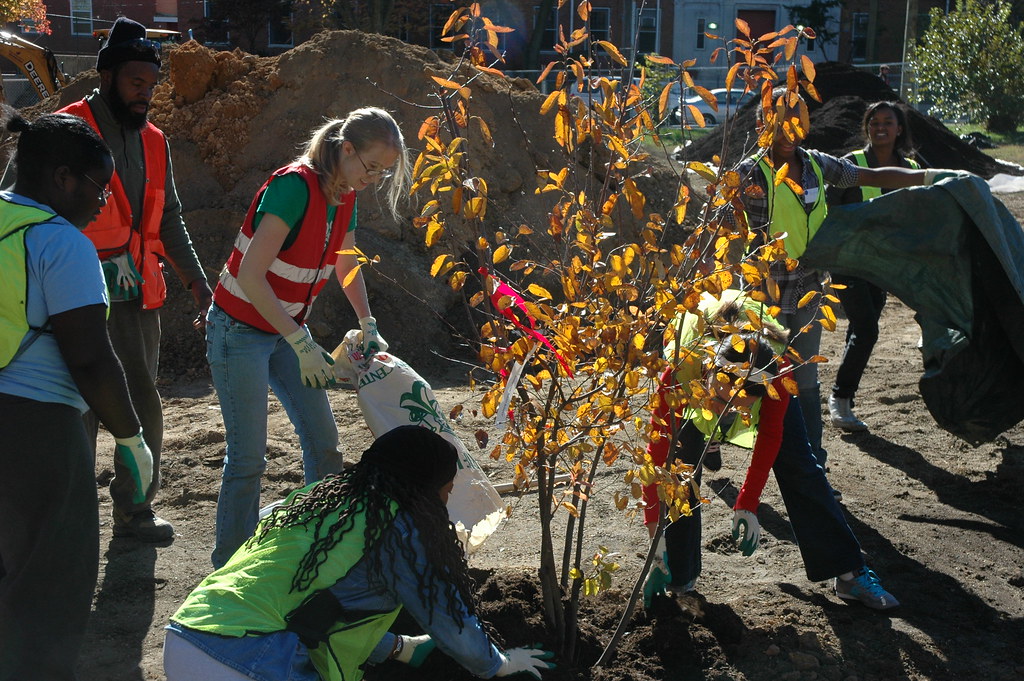 |
| Volunteers help plant a tree with brilliant foliage during a CTP last fall. |
So make a pledge to plant a tree at your home today. Our Tree Rebate program - good for up to $100 - can help. Doing so will guarantee you more fall foliage for you and your family to enjoy in the coming years.
Friday, October 7, 2011
What Is a Tree Worth?
To the people, animals, and environment around them, trees mean improved air quality, cleaner water and higher property value, among other things. But these abstract benefits are often hard to put a monetary value on, as they are priceless to those affected. However, for many people, the investment that must preclude this return may not be evident.
At Casey Trees, we plant 2.5 to 3 inch caliper trees, fit to withstand the urban conditions of the city. After taking into account the purchase, transportation and planting of these trees, Casey Trees pays about $250 per tree.
Since our start, we have always believed that the environmental and economic benefits of trees are worth far more than $250, which is why we have always provided and planted our trees at no cost to the community. 10 years and more than 10,000 trees later, we are still committed to that goal, and we’re asking you to help us continue achieving it.
By making a donation today, you can ensure that Casey Trees will be able to continue offering our services to our friends and neighbors throughout D.C. With your help we can do more to reach our canopy goals by bringing trees – and their many benefits – to our nation’s capital. Donations of any amount make a difference; however, we encourage everyone to consider covering the cost of one tree ($250) and become a tree sponsor this fall. Unless otherwise specified, every tree sponsor will receive special recognition on the Casey Trees website and the Casey Trees Map throughout our planting season.
After 10 years of serving our community, we ask you to decide how much this service is worth to you and to consider helping us make the investment in a happier, healthier, more beautiful D.C.
At Casey Trees, we plant 2.5 to 3 inch caliper trees, fit to withstand the urban conditions of the city. After taking into account the purchase, transportation and planting of these trees, Casey Trees pays about $250 per tree.
Since our start, we have always believed that the environmental and economic benefits of trees are worth far more than $250, which is why we have always provided and planted our trees at no cost to the community. 10 years and more than 10,000 trees later, we are still committed to that goal, and we’re asking you to help us continue achieving it.
By making a donation today, you can ensure that Casey Trees will be able to continue offering our services to our friends and neighbors throughout D.C. With your help we can do more to reach our canopy goals by bringing trees – and their many benefits – to our nation’s capital. Donations of any amount make a difference; however, we encourage everyone to consider covering the cost of one tree ($250) and become a tree sponsor this fall. Unless otherwise specified, every tree sponsor will receive special recognition on the Casey Trees website and the Casey Trees Map throughout our planting season.
After 10 years of serving our community, we ask you to decide how much this service is worth to you and to consider helping us make the investment in a happier, healthier, more beautiful D.C.
Casey Trees Nominated for a Hilly Award!
Thanks to your kind recommendations, Casey Trees is nominated for Nonprofit of the Year in the third annual Hilly Awards, put on by the Capitol Hill Chamber of Commerce.
Casey Trees has planted hundreds of trees in the Capitol Hill area. Of note are the more than 50 American elms along 8th Street SE that were planted in 2003 through Casey Trees’ American Elm Restoration program.
Additionally, Casey Trees will plant at Capitol Quarter, Greenseed Community Garden, Chamberlain Public Charter School and the Capitol Hill Montessori School during this fall’s Community Tree Planting season.
Voting for the 2011 Hilly Awards ends on Oct. 28 and the winners will be announced at an awards ceremony in November. Vote here!
Casey Trees has planted hundreds of trees in the Capitol Hill area. Of note are the more than 50 American elms along 8th Street SE that were planted in 2003 through Casey Trees’ American Elm Restoration program.
 |
| 2003 photo of American Elms planted on Barracks Row by Casey Trees. Take a walk down 8th Street SE to see how much these elms have grown! |
Voting for the 2011 Hilly Awards ends on Oct. 28 and the winners will be announced at an awards ceremony in November. Vote here!
Thursday, October 6, 2011
Welcoming Tour des Trees to D.C. on Saturday
Casey Trees is excited to welcome the riders of the 20th annual STIHL® Tour des Trees! Nearly 60 cyclists will ride into the District this Saturday for the second to last leg of the week-long, 485-mile cycling tour which benefits the Tree Research and Education Endowment Fund (TREE Fund). On Saturday, October 8, The Tour des Trees riders will visit the Casey Trees headquarters for lunch and tours of our bioretention planters and green roofs. They will also participate in a tree planting at the U.S. National Arboretum.
The seven day bicycle tour originates in Virginia Beach and stops in Wililamsburg, Richmond, Charlottesville, Front Royal, and Reston before concluding in D.C. Cyclists participate in tree planting and public awareness events at each stop. Casey Trees is a co-sponsor of this year's tour.
"Casey Trees is proud to be a Silver Sponsor of the 2011 STIHL® Tour des Trees," Executive Director Mark Buscaino said. "By supporting the Tour des Trees we are investing in urban forestry research that will significantly benefit the District's urban forest and its neighborhoods for generations to come."
After their visit to Casey Trees, the riders will finish the week-long tour at the American University Woods-Brown Amphitheater at 2:00 p.m. Closing ceremonies will immediately follow. Chuck Leavell, keyboardist for the Rolling Stones, will serve as keynote speaker and join the Tom Principato Band to entertain the crowds.
For more information, visit the Tour des Trees website.
Community Tree Planting Recap - First Fall Planting at Catholic University
Last weekend may have been rainy, but that did not stop Citizen Foresters — new and old — from showing up at the first Community Tree Planting (CTP) event of the fall 2011 season at The Catholic University of America! The planting was part of the Citizen Forester-qualifying Tree Planting class in which participants learned the basics of how to plant trees and the best places to plant them while taking our environment into consideration. They also learned tree anatomy and what trees are best suited for our climate. After a small break for lunch, everyone headed outside to plant the first 30 trees of the season.
The day was wet and dreary, but that didn't dampen the spirits of Casey Trees staff, Citizen Foresters and volunteers as we dug new homes for our woody friends. While everyone finished the day muddy and tired from planting, they can take pride in the work they did to improve CUA's campus by adding beautiful trees that will provide many benefits for future students.
With the help of volunteers, Casey Trees has planted 125 trees on five occasions at CUA. We were pleased by the impressive turnout — the largest Tree Planting class attendance in years! — and hope to see more of you at the rest of our plantings this season. Don't forget to check our website for the CTP and class schedule!
The day was wet and dreary, but that didn't dampen the spirits of Casey Trees staff, Citizen Foresters and volunteers as we dug new homes for our woody friends. While everyone finished the day muddy and tired from planting, they can take pride in the work they did to improve CUA's campus by adding beautiful trees that will provide many benefits for future students.
With the help of volunteers, Casey Trees has planted 125 trees on five occasions at CUA. We were pleased by the impressive turnout — the largest Tree Planting class attendance in years! — and hope to see more of you at the rest of our plantings this season. Don't forget to check our website for the CTP and class schedule!
Wednesday, October 5, 2011
Tree of the Month - Black Gum
We've chosen the black gum (Nyssa sylvatica) for our October Tree of the Month. Its leaves turn vibrant red in early autumn, before most other tree species put on their fall color. In the District we may not see the bright change until the end of the month, but it is a notable tree to look out for.
The black gum — also called black tupelo or sour gum — is a native tree found throughout eastern North America, from Southern Ontario and Maine all the way to Florida and Texas. It is a medium-sized deciduous tree, usually maturing at a height between 66 and 82 feet.
You can easily identify a black gum by its:
Fun facts about the black gum:
The black gum — also called black tupelo or sour gum — is a native tree found throughout eastern North America, from Southern Ontario and Maine all the way to Florida and Texas. It is a medium-sized deciduous tree, usually maturing at a height between 66 and 82 feet.
 |
| A black gum's brilliant fall color stands out against more late-changing leaves. Photo credit: dogtooth77. |
- Dark and furrowed bark. Some black gum bark resembles the scales of an alligator, making it particularly easy to recognize.
- Leaves, which are simple and oval-shaped with a rounded base. Dark green and glossy in the summer and peach or wine-red in the fall, the black gum's leaves are typically about two to six inches long.
- Small and greenish-white flowers, appearing in springtime with the leaves.
- Fruit, which blossoms when the leaves change color. Due to its early arrival, the sour fruit of a black gum attracts a lot of birds in early autumn.
|
|
Fun facts about the black gum:
- High in fat and fiber, the tree's fruit is an important food source for black bears
- In colonial times, the strong wood of the black gum was used for water pipes
- During spring season, the black gum qualifies for our RiverSmart Homes program!
Subscribe to:
Comments (Atom)









